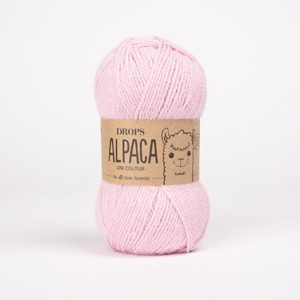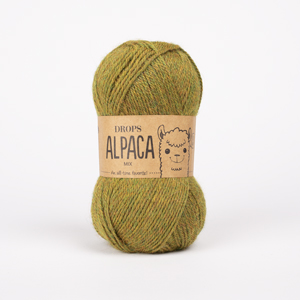Comments / Questions (23)
![]() Loredana wrote:
Loredana wrote:
Ik heb deze trui gebreid met Drops Baby merino wol, voor mijn kleinzoon heb ik maat 146/152 gebruikt, de lengte was voor hem te kort (voor de rest past hij prima!), dus mensen die deze trui gaan breien raad ik aan om een extra bol wol te bestellen als het kind een langer bovenlichaam heeft dan gemiddeld, want ik ben niet toegekomen met 300g.
29.11.2024 - 15:57
![]() Eva wrote:
Eva wrote:
Hallo, Ich finde den Pullover total toll. Möchte ihn bald Stricken (Wolle schon bestellt). Lese mich gerade in die Anleitung (bin keine blutige Anfängerin, aber auch nicht so sicher). Ist beim Vorder- und Rückteil beim „Abketten“ gemeint, einfach Maschen zusammen zu stricken und um die Anzahl verringern. „Abketten“ bedeutet für mich eher am Ende einer Arbeit zu sein. Freue mich auf Antwort. Lieben Dank Eva
04.04.2024 - 00:19DROPS Design answered:
Liebe Eva, die 8 Maschen beidseitig werden für das Armloch an beiden Seiten abgekettet, dann für die Passe kommen die Ärmel über diese abgeketteten Maschen - siehe Video. Viel Spaß beim Stricken!
04.04.2024 - 08:37
![]() Marie Laure wrote:
Marie Laure wrote:
Mon pt fils a 9ans et mesure 137cm.Dois je tricoter le modèle en 9ans ou en 11/12?
09.12.2023 - 15:48DROPS Design answered:
Bonjour Marie Laure, mesurez un vêtement similaire qui lui va et comparez ces mesures à celles du schéma, c'est la façon la plus simple de trouver la bonne taille. Retrouvez plus d'infos ici. Bon tricot!
11.12.2023 - 08:36
![]() Cristina wrote:
Cristina wrote:
Buongiorno! Sto lavorando il davanti/dietro di questo modello con i ferri circolari e sono arrivata al punto di dover intrecciare le maglie per lo scalfo. Non mi è chiaro come si faccia ad intrecciare le maglie a dx del segnapunti visto che lavoro sempre dal dritto. Grazie!
21.03.2022 - 08:09DROPS Design answered:
Buonasera Cristina, può tagliare il filo e intrecciare le maglie con descritto. Buon lavoro!
29.03.2022 - 22:57
![]() Jamie Epperson wrote:
Jamie Epperson wrote:
Hello! Thank you so much for making all of these wonderful patterns available. They are beautiful and always accurate. Great job DROPS Design! My question: In the YOKE section, there is this instruction: "Continue....bind off to shape shoulders. This bind off should occur on the stitches closest to the stitches on the holder or the stitches on the shoulder? Thanks for clarifying. Jamie
14.11.2021 - 19:11DROPS Design answered:
Dear Jamie, it's not for the shoulder, it's for the neckline. You bind off the stitches closest to the neck. Happy knitting!
14.11.2021 - 20:05
![]() Heide Biedermann wrote:
Heide Biedermann wrote:
Habe von meiner Schwiegertochter eine wolle Von Butt wolle ( Paola Color) erhalten . Soll für den Enkel Größe 158/164 einen Rustikalen Pulli stricken. Jetzt fehlt mir eine Anleitung dazu, hab Angeschlagen 97 Maschen ist das zu wenig.??
17.05.2021 - 16:55DROPS Design answered:
Liebe Frau Biedermann, ich kenne diese Wolle leider nicht, aber dieses Modell ist für eine Maschenprobe von 24 M x 32 R glatt rechts gestrickt = 10 x10 cm, wenn Sie diese Maschenprobe erhalten, sollten Sie dann die genauen Maßen wie bei der Maßskizze für die gewünschte Größe erhalten. Hier lesen Sie mehr über Maschenprobe. Viel Spaß beim stricken!
18.05.2021 - 08:11
![]() Couyet Nicole wrote:
Couyet Nicole wrote:
Bonjour, Auriez vous un modèle basique top down raglan pour adulte et enfant avec rehausse Merci Bonne journée
10.03.2020 - 14:15DROPS Design answered:
Bonjour Mme Couyet, vous devriez trouver votre bonheur parmi tous nos modèles de pulls tricotés en top down. N'hésitez pas à utiliser les filtres. Bon tricot!
10.03.2020 - 16:26
![]() Dalmazia Lodi Rizzini wrote:
Dalmazia Lodi Rizzini wrote:
Ho realizzato questa maglia con filato alpaca uni color color 6790 ha stinto nell'acqua e macchiato l'asciugamano dove l'avevo avvolto per asciugarlo. trovata bene per altri filati ma delusa. impossibile far indossare maglia a bimbo di sei anni
25.02.2019 - 05:35
![]() Stina wrote:
Stina wrote:
Werden die mittleren Maschen auf dem Hilfsfaden bei der Passe nicht mehr gestrickt? Wird ab da in hin- und Rückreihen gestrickt? Dann würde es auch Sinn machen warum Raglanabnahmen von links erklärt sind...
03.02.2019 - 15:51DROPS Design answered:
Liebe Stina, wenn die mittleren Maschen für den Halsausschnitt am Vorderteil stillgelegt sind, stricken Sie in Reihen weiter (Maschen werden auf beiden Seiten für den Halsausschnitt abgekettet), dann wird am Ende den Kragen gestrickt (die stillgelegten Maschen stricken Sie dann hier). Viel Spaß beim stricken!
04.02.2019 - 12:39
![]() Annika Hallberg wrote:
Annika Hallberg wrote:
Jag ser att ett garnalternativ till Alpaca är Safran. Men hur blir det då eftersom tröjan skall stickas i dubbelt garn? Blir det inte väldigt tjockt? Eller skall man sticka i enkelt garn om man använder Safran?
01.04.2017 - 16:25DROPS Design answered:
Hej Annika, Tröjan skall inte stickas i dubbelt garn enligt mönstret, så du kan sticka den i én tråd Alpaca eller én tråd Safran, du kan även sticka den i ett annat DROPS garn från garngrupp A. Lycka till!
03.04.2017 - 14:39
Vincent#vincentsweater |
|
|
|
|
Knitted sweater with stocking st and raglan in DROPS Alpaca. Size children 5 to 14 years.
DROPS Children 15-4 |
|
|
Garter sts (when knitting in the round on needle): 1st round: K 2nd round: P. Garter st (when knitting back and forth on needle): Knit all rows. Decreasing tips (applies to raglan): Dec as follows from RS: Start 3 sts before sts with marking thread (MT): K2 tog, K1, 1 sts garter sts (MT placed in this sts), K1, slip 1 st as if to knit, K1, psso. Dec as follows from WS: Start 3 sts before sts with marking thread: P2 into back of st tog (i.e. knit into back of sts instead of front of sts), P1, 1 garter st (= sts with marking thread), P1, P2 tog. -------------------------------------------------------------------------------- Back and front pieces: Work piece in the round on circular needles. Cast on 184-192-200-208-224 sts on circular needle size 2.5 mm / US 1 with Alpaca. Work 2 rounds garter sts – see explanation above. Continue in Rib K2/P2. When piece measures 3-3-3-4-4 cm / 1"-1"-1"-1½"-1½" K1 round at the same time dec 16 sts evenly = 168-176-184-192-208 sts. Change to circular needle size 3 mm / US 2or3 and insert 2 markers in piece as follows: 1st marker on beginning of round and 2nd marker after 84-88-92-96-104 sts (= marking sides). Continue with stockinette sts until piece is completed. When piece measures 5-5-5-6-6 cm / 2"-2"-2"-2⅜"-2⅜"- inc 1 sts on each side of both markers (= 4 increases), repeat inc on every 6-5-6-5-5 cm / 2⅜"-2"-2⅜"-2"-2" a total of 4-5-5-6-6 times = 184-196-204-216-232 sts. When piece measures 28-30-34-35-36 cm / 11"-11¾"-13⅜"-13¾"-14¼" bind off 8 sts on each side for armhole (i.e. 4 sts on each side of each marker) = 168-180-188-200-216 sts left in total for front and back pieces. Leave piece aside and work sleeves. Sleeve: Cast on 56-60-64-64-68 sts on double pointed needles size 2,5 mm / US 1 with Alpaca. Work 2 rows of garter sts. Continue in Rib K2/P2. When piece measures 3-3-3-4-4 cm / 1"-1"-1"-1½"-1½" K1 round at the same time dec 4-6-6-6-6 sts evenly = 52-54-58-58-62 sts. Insert a marker at beginning of round (= mid under arm). Change to double pointed needles size 3 mm / US 2or3 and work stockinette sts throughout. When piece measures 6-7-7-9-9 cm / 2⅜"-2¾"-2¾"-3½"-3½" inc 1 sts on each side of marker mid under arm, repeat inc on every 3-3-3.5-2.5-3 cm / 1⅛"-1⅛"-1¼"-⅞"-1⅛" a total of 9-10-10-13-13 times = 70-74-78-84-88 sts. When piece measures 34-38-42-44-48 cm / 13⅜"-15"-16½"-17¼"-19" bind off 8 sts mid under arm (i.e. 4 sts on each side of marker) = 62-66-70-76-80 sts. Put piece aside and make one more sleeve. Yoke: Slip sleeves onto same circular needle as back and front pieces where sts are bound off for armholes = 292-312-328-352-376 sts. Insert a marker in all transition between sleeves and back and front pieces. (Insert markers in first and last sts on sleeve) = 4 markers. Knit 1-1-0-0-1 rounds of stockinette sts. Then start dec for raglan as follows: Dec 1 sts on each side of 4 markers (= 8 dec) – read Decreasing tips. Dec on every other row 20-22-24-24-25 times and every row 3-3-3-6-7 times. AT THE SAME TIME when piece measures 40-43-48-50-52 cm / 15¾"-17"-19"-19¾"-20½" slip 24-26-26-26-30 sts mid front on a stitch holder for neck Continue and bind off to shape neckline on every other row: 2 sts 2 times. At completion of all dec for raglan there are 76-78-78-78-82 sts left. Piece measures approx 45-48-53-55-57 cm / 17¾"-19"-21"-21⅝"-22½" to shoulder. Neck band: Pick up 38-40-40-40-44 sts (including sts on stitch holder) on neckline of front piece = 114-118-118-118-126 sts. Change to double pointed needles size 2.5 mm / US 1 and knit K1 round at the same time dec 14 sts evenly = 100-104-104-104-112 sts. K 1 round, P 1 round and then continue in Rib K2/P2. When rib measures 6 cm / 2⅜" bind off loosely K over K and P over P. Assembly: Fold Rib on neckband double towards WS and sew on inside. Sew openings under arms. |
|

|
|
Have you finished this pattern?Tag your pictures with #dropspattern #vincentsweater or submit them to the #dropsfan gallery. Do you need help with this pattern?You'll find 24 tutorial videos, a Comments/Questions area and more by visiting the pattern on garnstudio.com. © 1982-2025 DROPS Design A/S. We reserve all rights. This document, including all its sub-sections, has copyrights. Read more about what you can do with our patterns at the bottom of each pattern on our site. |





























































Post a comment to pattern DROPS Children 15-4
We would love to hear what you have to say about this pattern!
If you want to leave a question, please make sure you select the correct category in the form below, to speed up the answering process. Required fields are marked *.